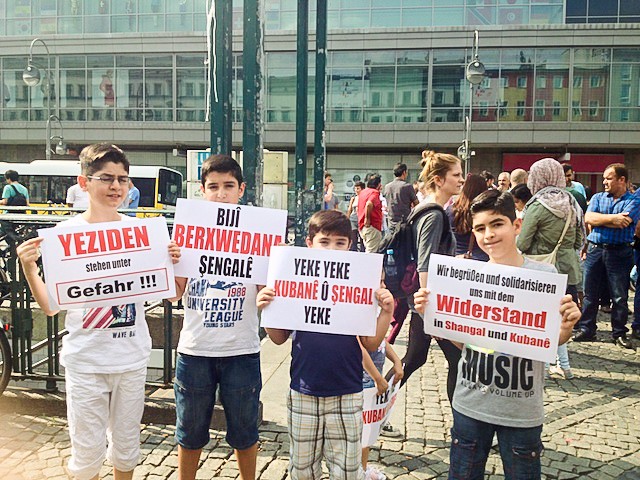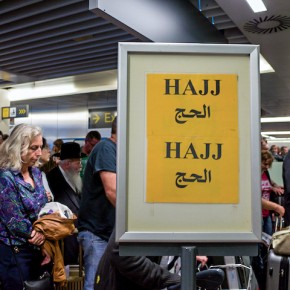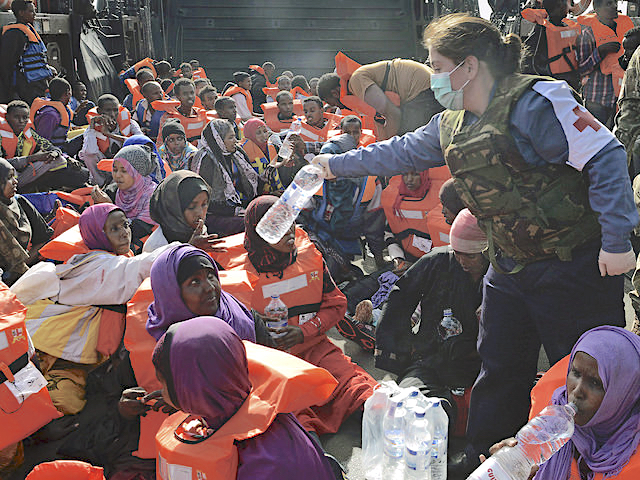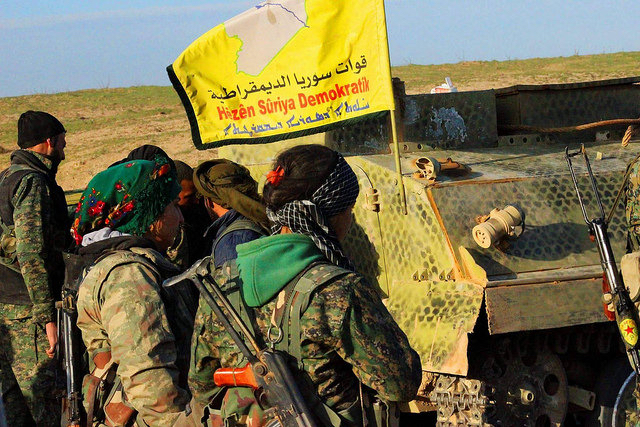Flags were flying everywhere. Kurdish, Turkish, Syrian, Palestinian. If you wanted to take inventory of where this neighborhood comes from, this would be the place to start. Police in riot gear milled through the crowd, taking stock of the situation, looking to be in place if things got out of hand. You could see the worry in their eyes.
Trying to figure out what the demonstration was about, an American couple wandered through the crowd, talking aloud, taking photos with their iPhones. Since everyone was speaking Arabic, their German was useless here.
Eventually, they found themselves standing in front of a group of young boys, with placards decrying the plight of Kurdish Yezidis (the the photo above) beseiged on a mountain top in northern Iraq by ISIS.
The experience was dislocating. Even though this was an area well-known for its Middle Eastern immigrants, it felt particularly out of place to these foreigners, precisely because of its foreignness. This was Germany? There wasn’t anything European about it. At least to their American eyes, unfamiliar with the nuances of life in Germany, today. Despite Berlin’s international rep, there was nothing even remotely like this in the Rough Guide.
It was the mix of politics and culture that did it. The freedom with which the demonstrators were expressing themselves, however outspoken, had a distinctly local vibe, epitomizing the city’s reputation as a place of the left, and the outspoken. Nowhere else in Europe can one find an assemblage quite like this. It was quintessentially Berlin, as much as it was Middle Eastern, making plain exactly what it is, at least politically, that draws immigrants to Germany.
The following flyer translations, recounting the crisis of a hunger strike, by refugees, in nearby Oranienplatz, testify to the significance of demonstrations like this one, in Hermannplatz, and why so many flee to Germany. It’s not just about getting asylum, in a wealthy country, with excellent social services. It’s also about being able to partake in an immigrant public sphere like this, with all the attendant politics, and security in numbers inherent in this crowd, in this square.
Demonstration on Monday
Resist
don’t give up!
Refugees on Oranienplatz started a hunger strike on 9 April so that they and their demands would not ignored like in previous “negotiations” with M. Kolat. The evacuation of Oranienplatz on 8 April did not happen peacefully, unlike what the media would have us believe. Many of the refugees were ignored during the negotiations, but they will not remain silent and have gone on hunger strike in order to secure their demands.
Talks are ongoing with Aydan Özoguz, the German Commissioner for Immigration, Refugees and Integration.
The refugee demands must not be ignored!
- Guarantee of a self-determined and self-organised reconstruction of the protesters’ information point and a separate tent for meetings, which should not be affected by the evacuation.
- Recognition of the occupied Gerhart-Hauptmann-Schule on Ohlauerstraße as a self-organised centre run-by and for refugees
- Residence permit for all refugee activists who have taken part in the Oranienplatz and school protests
- Section 23 of the residence laws must be used in order to ensure these demands
5 May 17.00
On Neptunbrunnen
Monday
Press release by the refugee activist of the tree sitting on Oranienplatz and the refugees on hunger strike in solidarity with those on Oranienplatz
Thursday, 10 April 2014
We are members of the refugee protest which has been on Oranienplatz since October 2012 to protest against camps, residence obligation and deportations.
The police and the canton will not allow me to drink, eat or have dry clothes until I agree to end my tree protest.
We started a solidarity hunger strike on Wednesday, which will continue until the protesters are allowed to drink, eat and have dry clothes.
The assumption that the resistance of the left-wing activists is dwindling due to the evacuation of Oranienplatz is wrong. More and more refugees are coming to Oranienplatz to protest.
Our resistance is about our demands, not Oranienplatz. We did not leave our countries to compete for Oranienplatz.
In order to evacuate Oranienplatz, the Senate made empty promises to give money and property if the refugees left Oranienplatz against the will of those who want to stay. This is a cleavage tactic used to pit people against each other and has been used repeatedly since the colonial period.
We will not end the protest or leave the tree until Dilek Kolat or other representatives in the Senate come to Oranienplatz to carry out negotiations and the info point accepted by the police as a place of protest.
We call for a common solution:
A peaceful solution for all is possible. Section 23 of the Residence Act is the key, as is made clear in a report by the Scientific Service of the German Bundestag. (Report attached)
- Abolish compulsory residence
- Homes instead of camps
- Stop deportations
- Right to work, equal rights and self-determined participation in all areas of social life
- Right to medical care and legal assistance
- Reconstruction of the event tent and self-made info, protest and networking point
- The Ohlauerstraße school should not be evacuated, but instead, become a refugee political centre
- Immediate resumption of negotiations (talks and solutions for all)
- Enforce Section 23 of the Residence as a solution for all in the Senate. The response then goes to the Federal Minister of the Interior Conference
- A meeting with the State Secretary for integration, so she can push through our demands and also the Section 23 in the Federal Minister of the Interior Conference!
- That all who were excluded from the list be put back on it
The protesting refugees on Oranienplatz
Translated from the German by Kit Rickard. Introduction and photographs courtesy of Joel Schalit.







